![]() 1st Battalion 22nd Infantry
1st Battalion 22nd Infantry ![]()
Service at Home 1906-1908
The regiment's annual target
practice for 1906 commenced May 19.
This season marked the first with the new Springfield rifles, the
U. S. magazine rifle, model 1903.

U.S. Rifle, .30 cal Model 1903
more commonly known as the Springfield rifle

The 22nd Infantry quick marches to the
"Front"
photo from 1906 Pacific Monthly magazine article about
the American Lake maneuvers
Maneuvers at American Lake
July 11, 1906, regimental
headquarters, band, headquarters first battalion and Companies A,
C and D, 22nd Infantry,
left for McDowell, Cal., en route to the coming maneuvers at
American Lake, Washington. This detachment stopped at Alcatraz,
where they were joined by Company H of the regiment, while
headquarters of the third battalion and Companies I and L
proceeded to Oakland, California, from the Presidio of
California. Companies K and M, coming from the depot of recruits
and casuals,
also proceeded to Oakland to entrain for American Lake.
The two sections of the Southern Pacific train carrying the
regiment arrived at Murray, Washington, the detraining point,
on July 13, and the regiment immediately went into the
comfortable and well-located camp at American Lake.
Following are the organizations which took part in the maneuvers:
Third Infantry, Seventh Infantry, Fourteenth Infantry,
Twentieth Infantry, Twenty-second Infantry, Regimental
headquarters and one squadron Second Cavalry, regimental
headquarters and six troops Fourteenth Cavalry; First, Ninth,
Twenty-fourth, Seventeenth and Eighteenth batteries of Field
Artillery;
Companies C and D, first battalion of Engineers; Company H,
Signal Corps; Company B, Hospital Corps, and several machine-gun
units.
The troops conducted a very successful and instructive series of
maneuvers lasting until the middle of September, 1906.
On the 15th of September the 22nd Infantry broke camp and the
several organizations returned to their proper stations.
Sergeant John H. Daub Company A
died at Camp Tacoma, Washington on July 22, 1906. His death was
recorded in the
Returns of the 22nd Infantry under the heading of Suicide with
the notation of "drowned in American Lake while mentally
deranged."
A newspaper article in the San Francisco Call stated
that he left behind a note to his Captain saying that he was
tired of his job.
1st Lieutenant----- |
The First Machine Gun Platoon In July, 1906, the War
Department issued orders |
The machine gun platoon Above is the collar disc |
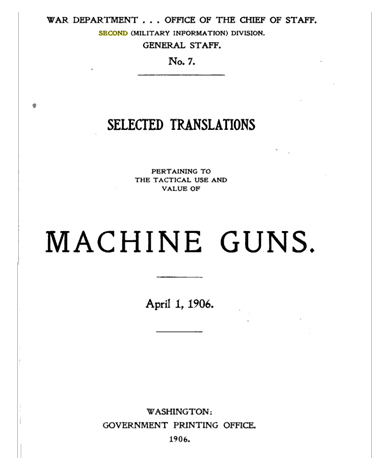
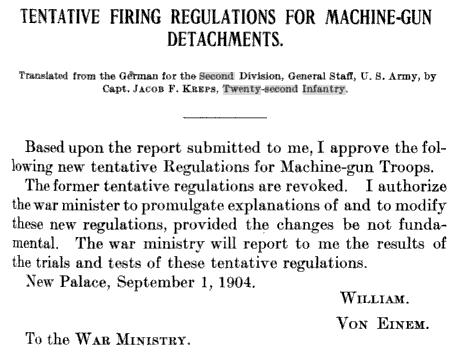
Editor's note: The US Army was slow to
accept the modern technology of the machine gun.
The German Army recognized the quantum leap the machine gun
offered, and led the world in the employment
of such weapons, and in formulating tactics in which they could
be used.
The above illustrations are from a US Army publication of 1906,
which informed about the use of machine guns,
and was nothing more than translations of texts written by and
for the German and French Armies.
The text on training with the machine gun was translated into
English by Captain Jacob Kreps, who,
on January 20, 1906, was appointed Commissary of the 22nd
Infantry.
|
General Order Number 14 This order established the
machine gun platoon The platoon became a part of
1st Battalion,
U.S. Army cal. 30 Maxim Model
1904 machine gun. |
On October 29, 1906, Special
Order No. 99 from the Headquarters Twenty-second Infantry,
detailed the following enlisted men from 1st Battalion for
service with the machine gun platoon:
Sergeant Willis Armstrong ----
Company A
Corporal James R. Somers ---- Company C
Corporal Louis D. St. Amant ---- Company B
Privates Clem J. Delose, William B. Elliott, Jeter Jarrett,
Benjamin Kinser, Nels O. Radley, and John J. Reid ---- Company A
Privates Sidney E. Henderson, Joseph Riha, Lionel Watson, Earl F.
White, William C. Wilson and Ames Wood ---- Company B
Privates Robert E.P. Davis, Frank J. Dunn, Patrick S. Driscoll,
Zeb. V. Fowler, Alexnder Powalisz and Frank E. Duffy ---- Company
C
Private Robert W. Windham
Company B died at the General Hospital at the Presidio of San
Francisco, California
on September 17, 1906. Cause of death was recorded as Miocarditis
& Diaphragmatic Pleurisy.
Private Eugene McWilliams
Company B died at the General Hospital at the Presidio of San
Francisco, California
on January 5, 1907. His death was recorded under the heading of
"by accident" with the notation of "Died of
gunshot wound made by accidental discharge of pistol. In line of
duty."
Corporal Roy H. Hamm Company D died at Fort McDowell, California
on January 29, 1907. His death was recorded
under the heading of Suicide with the notation of "died by
his own hand."
Establishment of the School of Musketry
In March, 1907, the School of
Musketry of the Pacific Division was organized and established at
the Presidio of Monterey, California.
Company C, 22nd Infantry, officered by Captain P. W. Davison, 1st
Lieutenant E. W. Terry and Second Lieutenant Dean Halford,
and the regimental machine gun platoon under First Lieutenant H.
A. Ripley, was detailed as a part of the school personnel.
These troops left Fort McDowell on March 22, 1907. Captain F. G.
Stritzinger, Jr., 22nd Infantry, was appointed an assistant
instructor
at the school. Second Lieutenants E. E. McCammon and C. B. Moore,
and one enlisted man from each company of the 22nd Infantry
were detailed to take the first course in the school of musketry.
Following the departure of Company C from Fort McDowell, Company
K was transferred to their barracks.
At the same time Companies I and L were moved from the Presidio
of San Francisco to the depot of recruits and casuals.
Annual target practice for 1907 was conducted by the
organizations of the regiment during May, June and July.
June 12, Field and Staff, 2nd battalion, and Companies F and H
moved from Alcatraz Island to the Presidio of Monterey;
June 24, Companies E and G, having completed their target
practice, moved from the rifle range to the Presidio of Monterey.
1st Sergeant Harry S. Hall
Company E died at the post hospital at the Presidio of Monterey,
California on
July 28, 1907. Cause of death was recorded as knife wound.
Private Gail E. Sittig Company M died at San Francisco,
California on August 10. 1907. His death was recorded
under the heading of Suicide with the notation of "While on
pass in San Francisco."
Private James Phillips Company B
drowned in San Francisco Bay, California on November 10, 1907.
Not in line of duty.
Battery Godfrey, the Presidio of San Francisco
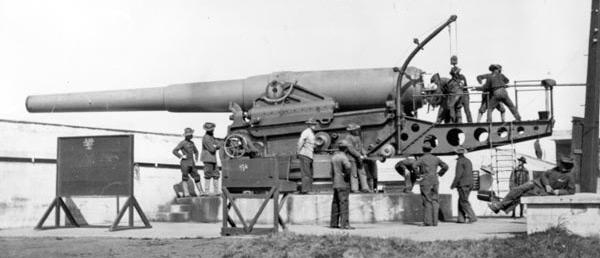
An artillery crew at Battery Godfrey
loads a projectile and powder bags into the breech of a 12-inch
gun.
The 1,070-pound shell was raised to the breech by a small crane.
Photo from National Park Service GGNRA
Completed in 1895, this
Endicott-era battery was armed with three 12-inch guns mounted on
barbette carriages.
The first 12-inch artillery platform in the nation was
constructed and tested at this battery. Battery Godfrey was built
to match or
outshoot the guns of contemporary battleships at ranges of up to
ten miles. These guns could fire one 1,070-pound shell per
minute.
Battery Godfrey was named in
honor of Captain George J. Godfrey of Company A of the
1st Battalion 22nd Infantry,
who was killed in action in the Bulácan Mountains , Island of
Luzon, Philippine Islands, June 3, 1900.
Battery Godfrey was located on
the northwestern end of the Presidio, as part of Fort Scott.
Its guns faced the Pacific Ocean, and were part of the Presidio's
defenses, from 1895 to 1943,
when the Army declared the guns obsolete and ordered them to be
scrapped.
Strike Duty at Goldfield, Nevada
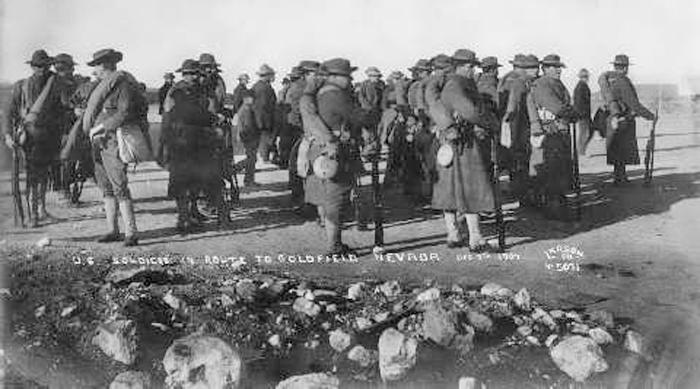
The 22nd Infantry enroute to Goldfield,
Nevada 1907
Photo from the P.E. Larson Collection, courtesy of the
Nevada State Museum, Carson City, Nevada
Nevada Department of Cultural Affairs
December 4, 1907 the regimental
commander was directed to place two companies in readiness to
move to Goldfield, Nevada,
for strike duty. This was due to an impending strike among :he
members of the local union of the Western Federation of Miners.
Companies B and K were selected by the colonel for this duty, but
on the following day the entire regiment, less the band and
Company C,
received orders to proceed immediately to Goldfield.
The regiment left Fort McDowell at 8 A. M., December 6, 1907, on
the army transport Slocum for Oakland, California,
the point at which the command was directed to entrain. The
following officers accompanied the first section of the regiment
on this service:
Colonel Alfred Reynolds, commanding;
Majors Daniel A. Frederick and Jacob F. Kreps;
Captain L. T. Richardson, adjutant;
Captain Orrin R. Wolfe, quartermaster;
First Lieutenant H. A. Ripley, adjutant, 1st battalion.
Company B: Captain George E. Stewart, Second Lieutenant Edward A.
Pearce.
Company D: First Lieutenant Robert Whitfield.
Company I: Captain William H. Wassell.
Company K: First Lieutenant John H. Baker, Second Lieutenant R.
V. Venable (attached).
Company M: First Lieutenant David A. Henkes.
Company A remained at Fort
McDowell to garrison the post and carry on the routine of guard
duty, etc.,
while Company L remained at the depot of recruits and casuals.
Upon arrival of the first section at Goldfield the town and its
inhabitants were found in a quiet and peaceful condition.
Camp was immediately established near the freight depot of the
Tonopah and Goldfield railroad.
These were the first United States troops ever seen in Goldfield,
Nevada.
The second section, arriving shortly after the first, went into
camp on the opposite side of town.
The following officers of the regiment accompanied this section:
Company E: Second Lieutenant
Edward E. McCammon (attached).
Company F: Captain Lawrence A. Curtis.
Company G: First Lieutenant Harry Graham, Second Lieutenant M. H.
Thomlinson.
Company H: First Lieutenant James R. Goodale, Second Lieutenant
John T. Burleigh.
Captain Curtis was in command of this detachment and First
Lieutenant Solomon B. West was adjutant.
General Funston, commanding the
Department of California, complimented the regiment
on the movement to Goldfield in the following letter to Colonel
Reynolds:
HEADQUARTERS, DEPARTMENT OF CALIFORNIA, San
Francisco, California,
DECEMBER 26TH, 1907.
COLONEL ALFRED REYNOLDS, 22nd Infantry, Fort McDowell, California.
SIR:
The department commander desires to express
his appreciation of the promptness with which you, on the 6th
instant,
after receipt of telegraphic orders, prepared your command and
embarked on vessel en route to train for Goldfield, Nevada.
Very respectfully,
J. W. DUNCAN,
Colonel, General Staff, Chief of Staff.
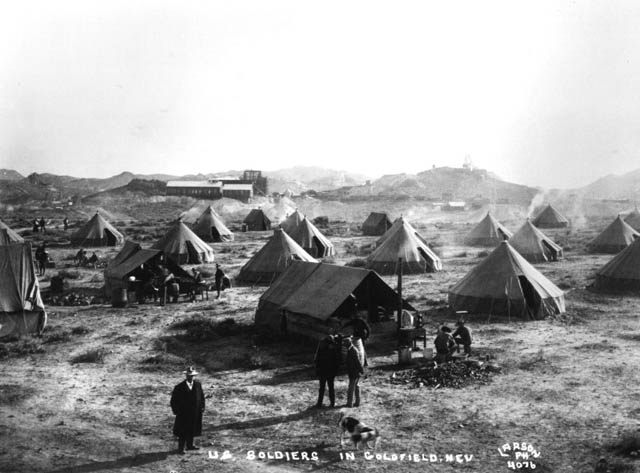
The 22nd Infantry encamped at
Goldfield, Nevada, 1907
Photo from the P.E. Larson Collection, courtesy of the
Nevada State Museum, Carson City, Nevada
Nevada Department of Cultural Affairs
The quiet and passive attitude
of the Goldfield miners indicated that there was no necessity for
troops to remain on duty in the town.
Accordingly, orders were issued directing the units of the
regiment to return to their respective stations on December 30.
Two days prior to that set for departure, however, this order was
revoked. The remainder of the service at Goldfield was
uneventful,
the troops suffering somewhat from the intense cold that
prevailed during December and January.
January 3, 1908, Companies H and I were filled to maximum
strength by transfers from the other organizations of the
regiment
and left on duty in Goldfield. The remainder of the regiment then
returned to its proper stations.
January 14, Company L moved from the discharge camp to the
Presidio of Monterey, and on February 12,
this Company was attached to the school of musketry for duty. At
the same time Captain Frank Halstead relieved Captain Joel R. Lee
in command of Company L, the latter officer having been
transferred to the 23rd Infantry.
March 7, 1908, Companies H and I were relieved from duty at
Goldfield and returned to their permanent stations,
the former to the Presidio of Monterey, the latter to the
discharge camp.
While at Goldfield Private
Edward W. Glendon of Company M was struck by a railroad train on
December 20, 1907.
The Returns of the 22nd Infantry for the month of December 1907
recorded that Private Glendon was
"Run over by train;
not in line of duty."
Above: From the Tonopah Daily Bonanza, |
Above: Photo by crfordy from the Find
A Grave page Edward W. Glendon served in
Company G of the 2nd Kentucky He served with the 1st Infantry
in the Philippines, with the 10th On September 11, 1906 he was
transferred to Company M |
Private Steven E. Green Company
E died in the hospital at the Presidio of Monterey, California on
February
25, 1908. Cause of death was recorded as pneumonia -- in line of
duty.
Sergeant Henry Johnson Company E died at the General Hospital at
the Presidio of San Francisco, California on
March 16, 1908. His death was recorded under the heading of Died
of Disease with the notation "In line of
duty."
On April 3, 1908, Captain
William H. Wassell, Company I 22nd Infantry, died at Fort Bayard,
New Mexico,
from exposure in the course of his service in the Goldfield
mining region.
The death of this gallant and
noble officer was a terrible shock to the remainder of the
regiment to which he had
so endeared himself; and it is fortunate that the 22nd Infantry
will always possess a tangible memory of his services,
for Captain Wassell prepared the history of the regiment from
1898 to 1904.
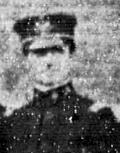
Captain William H. Wassell
Photo taken at Fort Crook, Nebraska 1903
Captain William H. Wassell is considered one of the primary
historians of the 22nd Infantry Regiment.
While on duty with the Regiment in the Philippines in 1904, he
and Captain Robert L. Hamilton
used the earlier writings of Major O.M. Smith concerning the
Regiment during the Indian Wars,
and brought the Regiment's history up to date by adding that of
the Spanish American War and
the Philippine Insurrection. Wassell served with the 22nd
Infantry in Cuba where he was wounded
at El Caney and was with the Regiment on both of its deployments
to the Philippines.
Wassell contracted pharyngitis
during the harsh winter at Goldfield and was hospitalized upon
return to
the Presidio in California. He was later transferred to the Army
hospital at Fort Bayard, New Mexico
where he subsequently died. His death was recorded as
"disease in the line of duty."
Captain Wassell's other writings
were published in various journals in the late nineteenth
century,
most notable of which was his work The Religion of the Sioux
, published in Harper's Magazine in 1894.
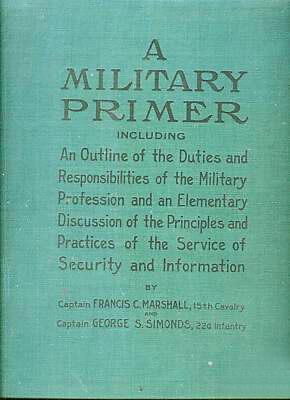
First intended as an introductory
textbook for Cadets at West Point, the above book was later used
to teach basic military
doctrine to officers and non-commissioned officers of the
National Guard. It was first published in 1907, and redone in
1908,
1913 and 1916. Its authors were CPT Francis C. Marshall of the
15th Cavalry, and CPT George S. Simonds of the 22nd Infantry.
In 1910 Simonds was the Regimental Adjutant for the 22nd
Infantry.
**********************
Most of the above narrative was
taken from the Regimental history published in 1922. Photos,
documents and additional text
added by the website editor.
The 1st Battalion 22nd Infantry
website is grateful to
the Nevada State Museum Department of Cultural Affairs
for permission to use the above two photos of the 22nd Infantry
at Goldfield, Nevada.
For more on the mining strike at
Goldfield and the history
of the State of Nevada, click on the banner below
to go to the Nevada State Museum Department of Cultural Affairs
website:
Home | Photos | Battles & History | Current |
Rosters & Reports | Medal of Honor | Killed
in Action |
Personnel Locator | Commanders | Station
List | Campaigns |
Honors | Insignia & Memorabilia | 4-42
Artillery | Taps |
What's New | Editorial | Links |